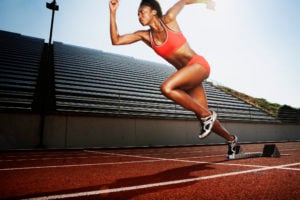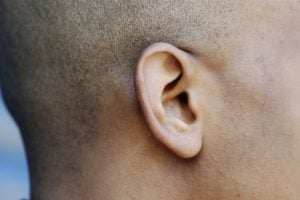
A runner looks determined as they begin their sprint down the track.
Dear Shannon Rowbury,
Last month, we attended an intersex conference with hundreds of other people with intersex traits, including more than a dozen children and youth.
We heard countless stories of people who were cut with a surgeon’s scalpel because the doctor decided that the beautiful intersex body they were born with was ugly and abnormal – or not “right.”
We heard many intersex adults express that they felt uncomfortable in sexual relationships, and we saw many people angry for being forced by doctors, parents, friends, and more into the arbitrary sex, gender, and sexuality binary molds.
These harmful views that force people into sex, gender, and sexuality boxes don’t come out of thin air. They are perpetuated by misinformed people who spread, intentionally or not, harmful messages about others.
Last month, you were asked how you felt about athletes like Caster Semenya and Dutee Chand – fellow Olympic runners from South Africa and India – being allowed to compete in Rio and your response highlighted the need for why we all need a more nuanced understanding of sex and gender.
You said, “I think it challenges and threatens the integrity of women’s sports to have intersex athletes competing against . . . genetic women . . . Women have fought far too long to be able to even have the right to compete and now it’s being challenged by intersex and trans athletes and I don’t think that’s right.”
As you compete in Rio, we hope you, other Olympians, and all the fans watching will add the following intellectual exercises to your routine:
1. Educate yourselves about the fallacy of sex and gender binaries
2. Ask: “What does racism and nationalism have to do with my ignorance and comfort with questioning, if not humiliating, others?”
3. Interrogate the ideal of fairness in sport
We ask you to do this because we don’t want an Olympian from our country, or any country for that matter, to run with intersex and transphobia.
Sex & Gender Binary Fallacy
There is not a single biological sex marker found exclusively in male bodies or female bodies.
Prior to the 1930s, scientists assumed that testosterone was a male hormone found exclusively in male bodies, and estrogen was a female hormone found exclusively in female bodies. But that theory was disproven in 1934 when Bernhard Zondek, a gynecologist, published a report that documented the presence of estrogen in the urine of male horses.
Genitalia are just as problematic of a biological sex marker. People with Androgen Insensitivity Syndrome (AIS) – an intersex trait both of us authors have – are born with vaginas, yet have undescended testes and XY chromosomes.
And as anyone who has struggled with reproduction knows, reproductive capabilities don’t define one’s femaleness or maleness; you don’t have to be capable of carrying a fetus to be female.
You wouldn’t say that women who aren’t intersex and can’t or choose not to have children aren’t really women, would you?
Gender, which is also believed to be binary, is problematically used interchangeably with sex, but gender and sex mean different things. Throughout much of the world, one is raised to be either a boy or a girl based on their sex categorization.
For instance, those with penises are taught by their parents, teachers, coaches, and teammates to be a man, whereas those with vaginas are taught to act like a girl. Society teaches boys not to cry and tells those who do to “man up.”
In competitive sports, girls are regularly insulted by the boys and men in their life with phrases such as “you throw like a girl,” as if girls can’t be powerful athletes and as if one’s athletic capabilities are tied to one’s gender.
Surely, you and your teammates can attest to how false this ideology is.
Sex and gender are spectrums, not binaries. They are not synonyms of each other.
Race and Nationalism
In our racist society, femininity is filtered through whiteness, leaving white people the arbiters of “true” femininity and women of color rendered less “feminine” than their white counterparts.
Around the turn of the last century, concepts such as “the fair sex” and the “cult of True Womanhood” welded domesticity and sexual purity with – surprise, surprise – white womanhood. These exclusive clubs that barred most women of color and poor whites were invented to maintain the unjust social class system that still lingers today.
Not surprisingly, women considered by some as early feminists – such as Abigail Adams – were complicit in the maintenance of these racist ideologies.
Today, evidence of this past rears its ugly head every time white people insist on labeling vocal Black women as angry, Latinx women as hypersexual, Arab women as oppressed, and some women – such as Caster and Dutee Chand – as not “genetic women.”
These stereotypes are not only false, but grounded in racialized sexism.
These stereotypes enable white people to consistently believe it’s not only their right, but their duty, to subject women of color to scrutiny, surveillance, and control. To lay the groundwork for this oppressive behavior, our society does everything it can to bar women of color from being allowed to fit in the western image of ideal femininity.
Women of color who are elite athletes from colonized countries, like India and the rest of the global south, face the added burden of western imperialism.
The ideology underlying western imperialism is an “us” versus “them” attitude.
It situates countries in the global north, like the USA, at the top of the geographical hierarchy. Once global north citizens are used to viewing the world from up there, they feel entitled to consume resources as they desire, while simultaneously swallowing up all the status and recognition they possibly can.
White-savior hipster companies like Toms Shoes are perfect examples.
Challenges to this hierarchy are often viewed as personal threats and attacks on “freedom” or the “American Dream,” and public humiliation strategies – such as questioning one’s body or gender – have unfortunately become a common response in Olympic athletics.
Recently, the International Association of Athletics Federations (IAAF) and International Olympic Committee (IOC) released policies designed to address how to approach women athletes with hyperandrogenism, a medical term for elevated, naturally occurring testosterone in one’s body.
These policies rest on a number of faulty assumptions, including the assumption that testosterone is significantly and neatly correlated with athletic performance, which science doesn’t support.
While some stakeholders deny allegations that these hyperandrogenism policies are about “sex testing,” the fact remains that these policies rely on testosterone levels to determine one’s eligibility to compete as a woman.
As such, a number of women have had their eligibility to compete questioned by these policies.
In extreme cases, some athletes have been forced to undergo genital “normalization” surgeries – such as the reduction or removal of their clitorises – in order to compete.
Two women in particular – Caster Semenya from South Africa and Dutee Chand from India – have been forced navigate the results of these tests that call into question not only their eligibility, but their sex and gender, on the world’s stage. Semenya and Chand have been diagnosed by the media and ridiculed in newspapers, blogs and interviews like the one you participated in.
Intimate details about these athlete’s genitalia, reproductive organs and hormones have been paraded in public without their consent by journalists, academics, and policymakers alike.
Shannon, when you suggested to the media that Caster Semenya is not a “genetic woman,” you publicly contributed to this humiliation circus that Semenya and Chand are currently facing.
Can you imagine what it must feel like to reach the highest level of athletic competition and for a competitor to discuss not your training or achievements, but your gender identity and – even more invasively – your genitals and sex chromosomes?
We doubt Semenya and Chand would be subjected to the same media scrutiny that they are currently facing if they were white Olympians representing the USA.
Why are people from the global north, including athletes and journalists alike, permitted and even encouraged to humiliate these women by scrutinizing their bodies and gender identities?
Shannon, if Semenya was a white teammate from the USA, would you still think it’s not “right” for her to compete? Would you still suggest she isn’t a “genetic woman”?
Fairness isn’t Fair
Even if we pretend (and this would be a big faulty assumption) that testosterone was directly and predictably related to athletic performance, what makes anyone believe that sports, especially at the elite level, were ever, or will ever be, fair?
How could one even disagree with the fact that countries in the global north have far more resources to train their athletes and prepare them for competitions than those in the global south?
The United States Olympic Committee, themselves, state that they have “established three Olympic Training Centers along with 17 Olympic Training Sites located in 15 states throughout the US. Millions of dollars were invested into these complexes to ensure athletes receive the best training in the country.”
Countries in the global south do not have the resources to build such remarkable training facilities, a fact not lost on these countries Olympic officials.
For instance, Indian Olympic Association secretary Rajeev Mehta recently stated, “Our sports suffer from lack of infrastructure. We stand nowhere in comparison to America, China, Britain, Holland.”
Shannon, do you think it’s “right” that you and other Olympians from the global north have access to the type of structural resources that elite athletes from the global south, who are mostly brown and black, can only dream about?
We certainly don’t think it’s right, but we do think it serves as evidence that what some label fairness in elite athletic competitions isn’t very fair after all.
Never mind the fact that athletes from some countries like Syria or Iraq might never get the opportunity to compete in the Olympics because of wars and general exploitation the global north repeatedly wage around the world.
And are we even going to talk about how even though a team of refugees is participating this year, close to one-hundred-thousand Brazilians were displaced?
Let’s again play pretend and assume none of the differences in structural resources and global inequalities matters when it comes to elite competitions, and instead look at the athletes themselves.
Should we not allow exceptionally tall athletes to play basketball because they were born with an unfair height advantage? Or what about those with long arms and legs, should we prevent them from competing in swimming competitions because of their extra long limbs? And what about those with perfect eyesight? What should we tell these folks?
Sorry, you can’t compete because you have an unfair advantage?
I know you’d agree that being really tall, having extra long limbs, or perfect eyesight would be advantages in some sports, but I’m sure you wouldn’t label their inclusion in competitions as being unfair or not “right.”
Athletes who have hyperandrogenism, or those who identify as having an intersex trait – which, for the record, neither Semenya nor Chand has stated – are not cheating.
They only desire to compete in their natural bodies, just like those who are really tall get to compete in their bodies.
Why is hyperandrogenism different than any other exceptional bodily characteristic found across the bodies of elite athletes – assuming, of course, that hyperandrogenism is an exceptional characteristic?
Perhaps this bias is because hyperandrogenism has been linked to sex – and even more risque, sexuality – by the media.
In your interview which we noted earlier, you incorrectly conflate intersex and trans, stating, “Women have fought far too long to be able to even have the right to compete and now it’s being challenged by intersex and trans athletes and I don’t think that’s right.”
Please stop doing this. Trying to bank off the general public’s ignorance, and for some fear, of trans and intersex people, to sheepishly imply that intersex and trans athletes are somehow cheating, is baseless and surely below an Olympian such as yourself.
As a former coach would always say to Pidgeon, “Let your performance on the field, not your words, do the speaking.”
Your Words Matter
Shannon, Shannon, Shannon with the fast white legs. We’re down with the part of your message about women’s rights.
Women do continually get the short end of the stick when it comes to athletics, and life in general, and we applaud you for speaking up about that.
Yet, your argument fails to take context into account, and illustrates why the word feminism often leaves a bitter taste in the mouths of people of color.
Saying that women such as Caster Semenya, or others with hyperandrogenism, threaten the integrity of women’s sports stirs up unnecessary fear and hatred.
Don’t believe us? Just read the comments underneath this video of your interview. The following are some of the highlights:
- “It’s about time someone spoke out. Nothing will change unless more women stand up for their rights. All women facing Semenya at the Olympics should sit on the starting line in protest.”
- “That’s no woman. She’s a man and a freak.”
- “A ‘woman’ with internal TESTES and no womb or ovaries. Caster SeMANya along with ‘Francine’ Niyonsaba and ‘Margaret’ Wambui should be tossed out immediately.”
- “She’s NOT completely a woman. She is a HERMAPHRODITE.”
- “She’s a freak and should be mocked!”
Sandwiched in the comments section, we noticed a mutual friend of ours and fellow intersex advocate, Eden Atwood, who responded to one of the commenters with vulnerability, logic, and rationality.
One of the commenters who seemed most excited by your comments responded to Eden’s vulnerability by calling her a “whore,” “cunt-face,” and a “half-half.”
Of course, you aren’t responsible for people’s behavior in the comments. Yet, we are sharing some of the comments with you because we hope you can understand how intersex and trans people – who you perceive as “threats” – are not actually threats to your sport.
Instead, they’re mocked, belittled, and can actually be threatened by people who get stirred up by false claims.
We all make mistakes, and initially Georgiann felt that’s what you did when you made those comments.
She didn’t think you meant harm, which is why she, and many other people in our community, reached out to you on Twitter asking for an apology after hearing your hurtful words about “genetic women” and your judgment about what’s not “right” when it comes to elite competition.
Instead of responding with compassion and understanding and wanting to learn, you blocked Georgiann and many of our friends one-by-one, adding salt to open wounds.
As an Olympian, you have the world’s attention with many seeing you as a role model. People around the USA are watching your speed and cheering you on, but they are also listening to your words including your uninformed and biased words about “genetic women” – which we trust the public will think about critically and reject.
When you erase intersex and trans athlete’s gender identities and label us threats, you are contributing to a legacy that consistently attempts to erase intersex and transgender folks by rendering us less than human and not deserving of equal rights – and that, Olympian, is not right.
[do_widget id=’text-101′]
Pidgeon Pagonis a Contributing Writer for Everyday Feminism. They are an intersex activist based in Chicago, working to help create a world in which every intersex baby that’s born has the right to bodily autonomy.
Georgiann Davis is an intersex scholar and activist originally from Chicago, Illinois. She joined the University of Nevada, Las Vegas’ Sociology Department in the fall of 2014 after spending close to ten years studying the intersection of the sociology of diagnosis and feminist theories. In her book Contesting Intersex: The Dubious Diagnosis (2015, NYU Press), she explores how intersex is defined, experienced, and contested in contemporary U.S. society. She is also the former president of the AIS-DSD Support Group (2014-2015), and a current board member for interACT: Advocates for Intersex Youth. You can read more about her work at www.georgianndavis.com.
Search our 3000+ articles!
Read our articles about:
Our online racial justice training
Used by hundreds of universities, non-profits, and businesses.
Click to learn more




















